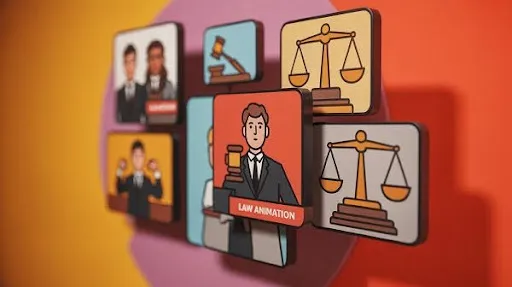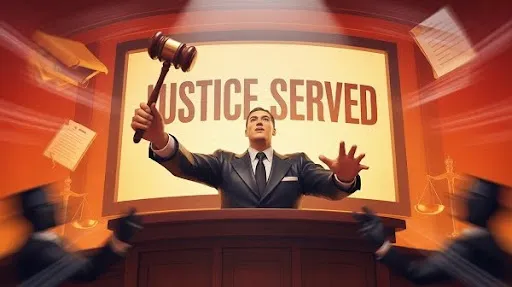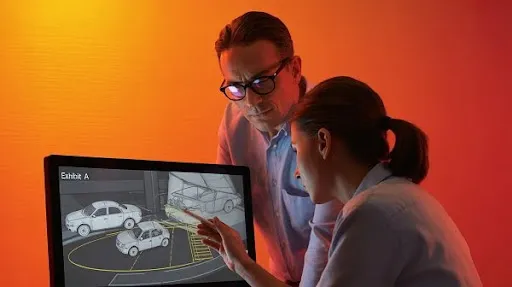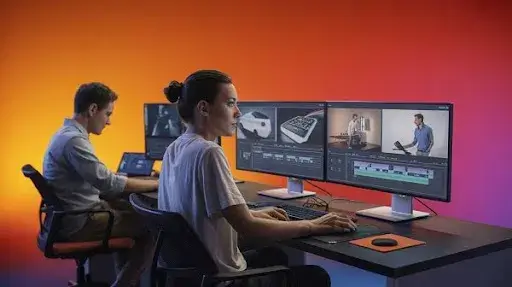In a trial, the way you present your evidence can be just as important as the evidence itself. That’s where law animation has started to change the game. Instead of relying on stacks of documents or static photographs, more attorneys are using motion-based visuals to show what actually happened.
And here’s the thing—people don’t just listen in court. They watch. They remember. They react.
Over the past few years, more and more legal teams have decided to choose to invest in law animation, often leveraging 3d video animation services because it gives them something that words alone can’t: a vivid, undeniable picture of events. It’s not just for big corporate lawsuits either.
From traffic accidents to environmental disputes, the benefits of using law animation are showing up in every corner of the legal world.
What Is Legal Animation
So, what is legal animation? Think of it as a storyteller that works for your case. It’s a type of demonstrative evidence—like photos or diagrams—but in motion. You might use it to re-create an accident scene, walk through a medical procedure, or explain the sequence of events in a complex dispute.
It’s not the same thing as a simulation. Simulations need to be scientifically exact to be admitted as hard evidence. Legal animations, on the other hand, are there to support testimony, not replace it. They take what your witnesses or experts are saying and put it into a form that jurors and judges can see play out right in front of them.
And it’s not just for the courtroom. The world of law animation also extends into mediations, depositions, and pre-trial negotiations. The purpose stays the same: make facts clear, easy to follow, and hard to dispute.
The Impact of Law Animation on the Legal Industry
The impact of law animation on the legal industry is bigger than most people realize. Not long ago, trial visuals were mostly charts on poster boards or maybe a grainy video clip. Now? Courts are used to seeing detailed, high-quality animations that walk them through exactly what happened.
Jurors have grown accustomed to it. They expect visuals. And when an attorney comes in with polished, accurate visuals, it sets a certain tone—they’re prepared, they care about making the facts clear, and they’ve invested in the case.
That shift has pushed a lot of law firms to adapt. It’s no longer about just presenting your case—it’s about presenting it in a way that sticks.
What is the Rule of Law
The Rule of Law is an essential principle that sets the foundation for a fair and organized society. It pertains to a system where citizens and government officials are legally bound and held responsible for their actions.
The Rule of Law guarantees that laws are enforced impartially and equitably and that no one is exempt from following them.
Legal Certainty: Laws must be transparent, predictable, and accessible to all individuals. This ensures that people can understand and plan their actions accordingly, knowing the legal consequences.
Equality before the Law: The Rule of Law requires that all individuals are equal in the eyes of the law. No one should receive special treatment or privileges based on their social status, wealth, or other arbitrary factors.
Fair and Impartial Judiciary: An impartial judiciary should interpret and apply laws without bias or undue influence, ensuring fair resolution of legal disputes.
Respect for Human Rights: The Rule of Law safeguards and upholds fundamental human rights and freedoms. It ensures that individuals are protected from arbitrary actions by the government and others.
The Rule of Law is vital for an orderly society. It protects individual rights, fosters social stability, promotes economic development, ensures accountability and limitation of power, upholds democratic governance, and prevents injustice, instability, and abuse of power.
Benefits of Law Animation in Winning Cases
The benefits of law animation go way beyond making things “look good.” Done well, it can influence how people process information and remember it. Here’s why attorneys are turning to it more and more:
1. Better Memory Retention
We tend to forget most of what we only hear. Add visuals to that, and suddenly, retention jumps. By giving jurors something they can see while they listen to your testimony, you make it far easier for them to recall the important points when they deliberate.
2. Filling Gaps Where No Video Exists
Not every moment in a case gets caught on camera. Animations can show events like a machinery malfunction, a medical injury, or an environmental impact—things no one filmed, but everyone needs to understand.
3. Simplifying Complex Details
Some topics—like engineering data or medical procedures—can sound like another language to a jury. Effective law animations turn that into something visual and easy to grasp without watering down the facts.
4. Making Expert Testimony Land Better
Experts often deal with technical information. By pairing their words with animation, you give jurors a double layer of clarity—something to look at while they process what’s being said.
5. Controlling the Narrative Without Bias
When made carefully, animations stay true to the evidence but still guide the audience’s focus toward the key points. It’s persuasion rooted in accuracy, not exaggeration.
Real-World Scenarios
Here’s where law animation can help you win more court cases in practical, real-life ways:
- Personal Injury: Showing the exact mechanics of an injury, frame by frame.
- Medical Malpractice: Breaking down a procedure so the jury can follow every step.
- Criminal Defense: Re-creating the sequence of events from different angles.
- Product Liability: Demonstrating how a product’s defect leads to harm.
- Environmental Law: Mapping out the visible effects of contamination or damage.
In all these examples, you’re giving jurors a way to see what words alone might not fully convey.
The Strategic Edge of Effective Law Animations
Working with a law firm that knows how to use visuals well can be a game-changer. The animation becomes part of the overall narrative—woven into the arguments, not just tacked on as an afterthought.
Say you’re dealing with a high-stakes construction dispute. You could spend hours explaining structural failures in technical terms. Or you could show a short, accurate animation of the collapse sequence. In most cases, the second option leaves a deeper, more lasting impression.
Advanced Strategies for Law Animation in Trials
Not all animations are equal. Some are just visuals. Others? They actually make jurors sit up and pay attention. The trick is integrating the animation into your story, not just showing it for the sake of it. That’s where strategy matters.
One method is layering information. Show the big picture first. Then zoom into the crucial moments. It’s like telling a story—jurors understand better if they get context before the details. And it keeps them from feeling overwhelmed.
Another approach is using multiple perspectives. Take a car accident, for instance. Show an overhead view first, then switch to a driver’s point of view. Add a close-up on a critical detail. Jurors suddenly “get it” in a way words alone can’t deliver.
And don’t overlook blending animation with real evidence. Photos, videos, and even forensic scans can be layered in. This keeps your animation anchored in reality and makes it more persuasive.
Common Challenges
Here’s the thing—animations can backfire if not done carefully. Opposing counsel will try to find a flaw. Expect it.
Accuracy concerns: Everything must align with the evidence. Experts should check every detail. Otherwise, credibility suffers.
Bias perception: Avoid dramatic effects—no ominous music, no exaggerated motion. The goal is clarity, not theatrics.
Technical quality: Poor visuals can hurt your case. Work with professionals who know how to make effective law animations that are smooth and precise. It’s worth the investment.
Real-World Wins Using Law Animation
Seeing is believing. Here are some real-life examples:
- Medical Malpractice: A step-by-step surgical animation helped jurors understand the procedure. Outcome? They sided with the surgeon.
- Traffic Collisions: A trucking accident animation showed reaction times clearly. The jury awarded the plaintiff damages.
- Construction Disputes: An animation depicting a building collapse helped settle a case in arbitration before trial.
These examples show that law animation can help you win more court cases by clarifying things jurors otherwise struggle to visualize.
Working With a Law Firm That Embraces Animation
Not every firm gets it. But if you’re working with a law firm that values visuals, you’re ahead. They know how to:
- Bring animators and experts in early.
- Predict and counter opposing arguments.
- Use animations strategically, not as filler.
The difference is huge. Instead of just explaining events, jurors see them. And that sticks.
Best Practices for Creating Law Animations
Some tips to make sure your animations hit the mark:
- Start early: Rushed animations never work. Draft, review, revise.
- Stick to the facts: Every frame should match the evidence.
- Consult experts: Doctors, engineers, or forensic specialists should verify details.
- Focus on clarity: Keep visuals simple and highlight what matters most.
- Be ready for scrutiny: Expect tough questions and be able to defend each part.
Following these steps makes your animation both persuasive and court-ready.
The Future of Law Animation
The impact of law animation on the legal industry is still evolving. Virtual and augmented reality may soon let jurors explore scenes interactively. Imagine walking through a reconstructed accident.
Even now, though, 2D animation services and 3D animation services dominate. Firms adopting them early get a clear advantage. Small teams can compete with big players if they use animation thoughtfully.
Frequently Asked Questions
How accurate should law animations be?
Close enough to reflect reality and support evidence. They don’t need to be perfect simulations.
Can animations replace experts?
No. They complement testimony. Jurors still need someone to explain and validate what they see.
Are animations admissible in court?
Yes, if fair, accurate, and not prejudicial. Rules vary by court, but demonstrative animations are generally allowed.
How long does it take to make an animation?
Small cases might take a few weeks. Complex ones could take months. Start early.
What’s the difference between animation and simulation?
Animation illustrates testimony. Simulation is scientifically exact and often used as substantive evidence.
Do all cases benefit from animation?
Not all. But complex cases, technical disputes, or missing footage situations often gain a big advantage.
Final Word
Static images and long-winded testimony aren’t enough anymore. Law animation transforms facts into stories that stick.
Attorneys who choose to invest in law animation gain more than visuals—they gain clarity, credibility, and a real edge in court. For law firms aiming to win, working with skilled animators ensures every frame supports your strategy.
At Prolific Studio, one of the best animation studios in San Francisco, we specialize in the creation of law animations that are precise, compelling, and tailored to your case. Ready to turn your evidence into a story jurors can’t forget? Let’s bring it to life.
Related articles:









